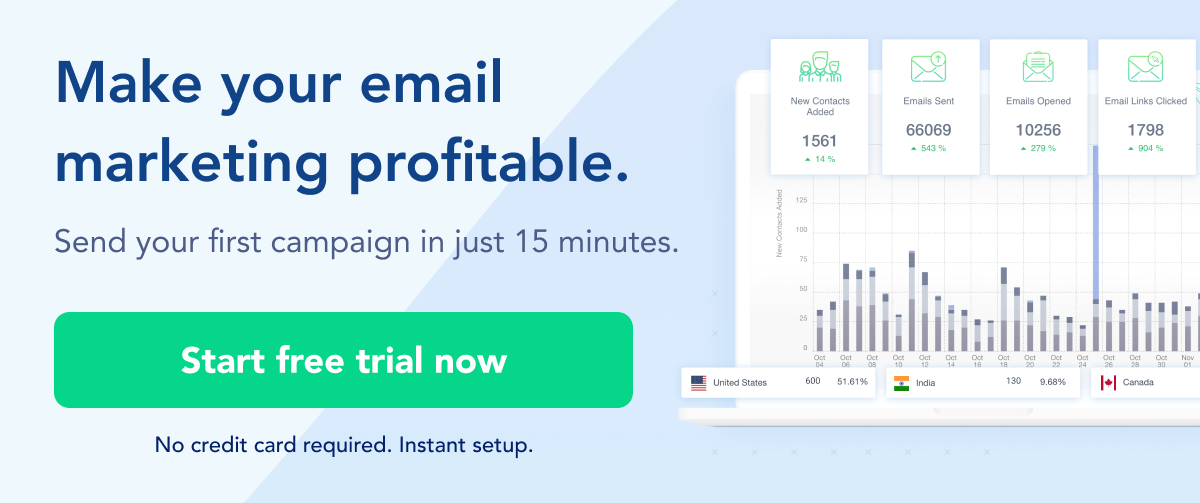Is your email click-through rate (CTR) as good as it should be? Establishing solid CTR benchmarks can help you determine whether your email campaigns are driving the engagement that you want.
If your CTR falls below the benchmark, it might be time to up your game.
But what exactly is the benchmark for CTR, and how do you know if you’re missing, meeting, or exceeding it? Are industry averages really that important, or should you concentrate on meeting your internal CTR benchmark?
We’ll answer all those questions in this article. And we’ll throw in some tips to help you improve your click-through rate. But first, what does CTR mean in email marketing?
Table of Contents
What Is a Click-Through Rate in Email Marketing?
Your click-through rate (CTR) measures how many subscribers click on one or more links in your email. It tells you whether your emails are being read and engaged with by your audience.
CTR is one of the most effective metrics for accurately measuring your email marketing performance. According to an Ascend2 survey, marketers deem CTR to be just as important as return on investment and average conversion rate for analyzing email campaign success.
Source: Ascend2.com
What Is a Benchmark CTR?
In marketing, a benchmark is a standard or reference point against which you can compare results. So, CTR benchmarks refer to average click-through rates that you can use to observe whether your email click-through rate is where it should be.
If you’ve got the data, identifying your internal CTR benchmarks should be your priority. This involves calculating your average clickthrough rate over a certain period. You can use this figure to regularly check whether you’re meeting, exceeding, or falling short of your optimal CTR performance expectations.
But what if you have no data of your own?
Knowing CTR benchmarks for your industry and subscriber list size gives you a good point of reference for how you should be performing. For example, companies with larger lists tend to see lower average CTRs than those with smaller lists. Similarly, B2B companies typically have higher click-through rates than B2C companies due to the different ways that each customer base engages with marketing emails.
Source: HubSpot.com
HubSpot confirmed this when they used their own benchmark data to discover that B2B organizations that sent 16-30 email campaigns on a monthly basis generated a median 6% CTR. In contrast, B2C organizations that sent the same amount had a median 5.6% CTR.
How Do You Calculate CTR Benchmarks?
So, what is your average email marketing click-through rate? To calculate your email CTR, you can use the following formula:
(Number of people who clicked a link inside your email / Number of successfully delivered emails) x 100
So, let’s say that you sent emails to 500 of your subscribers, and 25 of them clicked your call-to-action. You’d divide 25 by 500 and then multiply the result by 100, giving you a click-through rate of 5%.
What Is Considered a Good CTR?
Average click-through rates vary significantly by industry, so there are no hard rules for what’s considered a “good” CTR. Some industries, like government, education, and real estate, tend to have higher CTRs because of the type of information that they communicate. In contrast, retail has one of the lowest conversion rates and CTRs.
Cloud-based services, such as PaaS or SaaS marketing, may also see a higher CTR by industry. This is because digital channels are the main line of communication for digital items.
Other factors that influence your CTR include the type of email you’re sending, your location, your subscriber list size, and whether you’re a B2B or B2C company.
Generally speaking, across all industries, an average CTR is about 1.4%. So, if your CTR is below this or you’re on the lower side of your industry benchmark, it’s time to work on improving your click-through rate.
Source: smartinsights.com
How to Improve CTR to Meet Benchmarks
As we mentioned earlier, CTR is a fundamental metric for measuring your campaign's success. If readers aren’t clicking the links inside your emails, then they’re not going on to convert. So, what can you do to improve your CTR?
Capture Attention With Compelling Subject Lines
Meeting CTR benchmarks will be impossible if you can’t get subscribers to open your emails in the first place.
Customers receive dozens of emails every week. To prevent your email from getting lost amongst the junk — or, even worse, from being marked as spam — you need to create compelling subject lines.
The best email subject lines grab your reader’s attention, compelling them to open the email to see what you have to say. A good email subject line:
- Sparks the reader’s intrigue.
- Is relevant to the recipient’s interests.
- Creates a sense of urgency or exclusivity.
- Spotlights value propositions.
Segment and Personalize Your Emails
Do you send the same emails to everyone on your email list? If so, you risk sending irrelevant emails to huge chunks of your target audience, lowering your open and click-through rates.
To segment your email list, group your subscribers based on their interests, location, demographics, and anything that may influence their digital marketing preferences. From there, you can target subscribers with tailored content that’s relevant to their interests.
Personalizing your emails is important — and it takes more than simply addressing the recipient by name. A personalized email provides valuable insights and relevancy to the reader, appealing specifically to their needs.
For example, let’s say that you’re a clothing store wanting to recommend your new seasonal stock to your potential customers. You might segment your target audience based on age, gender, or household income. From there, you can tailor the email’s content to make it more appealing to the different groups.
Because the email is personalized to them, subscribers will be more interested in the content and, as a result, more likely to click through.
If you’re struggling to find relevant content, utilize SEO and content marketing strategies. The pages that your subscribers viewed before they signed up for your email list are key indicators of the type of content that they like to consume. Enlist the services of a B2C or B2B SEO company that can help you accurately segment customers and identify the right keywords to use in your subject lines and email copy.
Use a Strong CTA
Your CTA is the catalyst for conversion. It tells your subscribers exactly what action they should take next and physically delivers them to where you want them to be. So, it’s vital that you get it right.
A strong CTA is one that:
- Is action-oriented.
- Stands out from the rest of the email content.
- Creates a sense of urgency.
- Is concise and to the point.
Optimize for Mobile
A customer who opens your email is interested in what you have to offer. But if your emails don’t load properly on their mobile device, they’ll give up reading and abandon your email, hurting your CTR potential.
Most emails are opened on mobile devices, so double-check that your emails are mobile-friendly. Preview your email on various screen sizes and ask yourself the following questions:
- Is your design responsive?
- Are your font sizes too big or too small? Are they legible?
- Are your images and videos in the right places? Are they loading correctly?
- Is your content easily scannable for readers on the go?
- Does your CTA display as intended?
A/B Test Your Emails
Try A/B testing your emails to see which ones garner the most click-throughs. A/B testing involves splitting your email list into two segments and sending two different versions of the same email to see which one performs best. You could test everything from:
- Subject lines: Play around with the length of your subject lines as well as wording, emojis, and other techniques.
- Email design and layout: Do your subscribers prefer colorful, creative email designs, or are they more receptive to simple, traditional layouts? What type of visuals do they prefer, if any?
- Email copy: There are lots of different elements of your email copy that you can test. Experiment with email length, tone of voice, calls-to-action, button copy, and more.
Automate Your Marketing Campaigns
63% of businesses use email marketing automation. If you want to keep up with the CTR benchmarks set by your competitors, then you’ll want to follow suit.
Source: Image created by writer
The best email marketing platforms boast a variety of features that not only help you create click-worthy emails but enable you to streamline email marketing management.
Build beautiful emails using no-code editors. Automate list segmentation and tagging. Run A/B tests right inside the platform. And so much more.
Use CTR Benchmarks to Measure the Effectiveness of Your Email Marketing Campaigns
Encouraging subscribers to click on the links in your email is an ongoing challenge that most marketers face. But instead of being left in the dark, utilize industry and internal CTR benchmarks to analyze your performance.
Whether you’re aiming to meet and beat the average rate by industry or hit your monthly targets, use CTR benchmarks to verify the success of your email marketing campaigns. If you’re falling short, leverage the tips above to improve your click-through rate and lead customers toward conversion.



